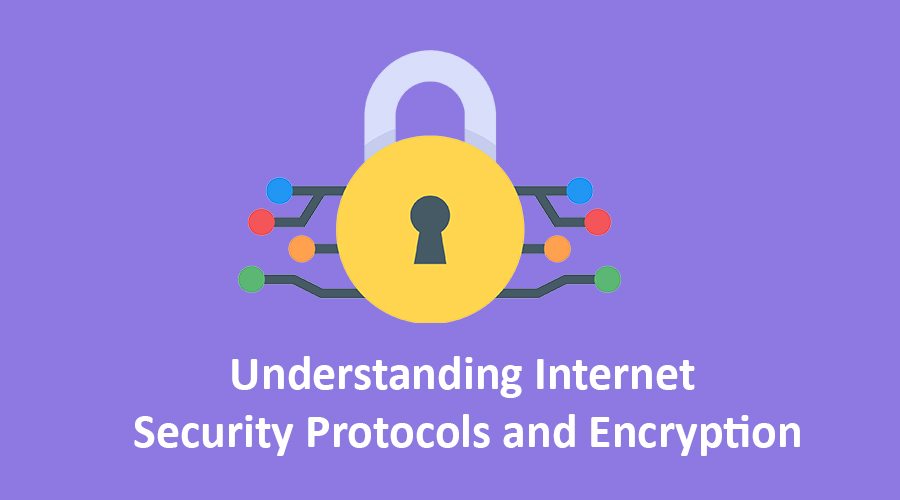
Security protocols and encryption are the binder that hold up the fort of protection throughout the internet, safeguarding data against unauthorized access, interception, and tampering. For most folks, this knowledge might end at the “https” prefix in web addresses and the reassuring padlock icon in the browser's address bar. Or they might think of authentication protocols when logging into secure websites.
These are just part of the security protocols like TLS/SSL used to protect users' data during online interactions. This quick article will be like your favorite essay service, crafting a superb paper on security protocols and encryption for you. Let’s dive in!
1. TLS/SSL (Transport Layer Security/Secure Sockets Layer)
Transport Layer Security (TLS) and its predecessor, Secure Sockets Layer (SSL), are cryptographic protocols designed to establish a secure and encrypted connection between a user's web browser and a web server. This secure tunneling ensures the integrity of the data during transmission.
TLS/SSL serves as the digital bouncer, allowing only authorized parties to access the data. It accomplishes this through encryption, which scrambles the data into an unreadable format for anyone trying to intercept it. The protocols also provide authentication, ensuring that the website you are connecting to is indeed the one it claims to be.
Role of TLS/SSL in Securing Internet Communication
Picture this: you're about to make an online purchase, entering your credit card details. How can you be sure that your sensitive information won't fall into the wrong hands? This is where TLS/SSL comes in.
When you see “https” or a padlock symbol in your browser's address bar, it means that TLS/SSL is in action. This visual cue tells you that your connection is secure, shielding your data from eavesdropping and tampering.
In other words, TLS/SSL is the invisible shield that guards your personal information when you shop online, log into your bank account, or send confidential emails. It's the reason you can trust online transactions.
Implementation and Encryption Algorithms Used
TLS/SSL employs a robust combination of encryption algorithms to ensure that data is secure. Two of the most prominent algorithms are RSA (Rivest–Shamir–Adleman) and AES (Advanced Encryption Standard).
RSA is a widely used public-key cryptosystem that enables secure data transmission by encrypting and decrypting messages. In layman's terms, it's like having a special lock on your digital door, where only the recipient has the matching key.
AES, on the other hand, is a symmetric-key encryption algorithm. It's like having the same key to both lock and unlock a door. This makes data transmission faster and more efficient.
Together, RSA and AES work harmoniously to establish a secure connection and encrypt your data.
Examples of Websites and Services Using TLS/SSL
TLS/SSL has been widely adopted on the internet, with countless websites and online services prioritizing user security. Here are some real-world examples of popular platforms that employ TLS/SSL:
Google: When you use Gmail or conduct a search on Google, your data is protected by TLS/SSL.
Online writing services: When you’re looking for an essay to buy and making payments, TLS/SSL ensures your payment information remains confidential.
Online Banking: Your bank's website uses TLS/SSL to safeguard your financial transactions.
Social Media: Popular social networks like Facebook and Twitter rely on TLS/SSL to protect your login credentials and personal messages.
These examples illustrate how TLS/SSL is pervasive over the internet, securing your digital experiences in the background.
Next, we explore the vital role of IPsec in securing virtual networks and beyond.
IPsec (Internet Protocol Security)
Internet Protocol Security, otherwise known as IPsec, are protocols designed to secure internet communications at the network layer. Unlike TLS/SSL, which operates at the application layer, IPsec safeguards data at a deeper level, ensuring that packets of information remain confidential and tamper-proof during their journey across the internet.
Use Cases for IPsec (e.g., VPNs)
One of the primary applications of IPsec is in Virtual Private Networks (VPNs) which are used to establish secure connections over the internet both corporately and indivudally. Here's how IPsec contributes to the security of VPNs:
Remote Work: In the era of remote work, employees access company resources from various locations. IPsec ensures that these connections are secure, safeguarding sensitive corporate data.
Online Privacy: Privacy-conscious individuals use VPNs to anonymize their internet activity. IPsec ensures that the data transmitted through VPNs remains confidential.
Secure Data Transmission: Whether it's transmitting financial data or healthcare records, IPsec adds a layer of security, making sure that the information remains intact and inaccessible to unauthorized parties.
Encryption Algorithms and Modes in IPsec
IPsec offers a variety of encryption algorithms and modes to suit different security requirements. Some of these commonly used algorithms include:
Triple DES: A symmetric-key encryption algorithm that encrypts data using three separate keys, making it highly secure.
AES: Just like in TLS/SSL, Advanced Encryption Standard is widely used in IPsec for its efficiency and robust security.
SHA (Secure Hash Algorithm): SHA ensures data integrity by generating a unique hash value for each transmitted packet. If the data is tampered with during transmission, the hash value changes, alerting the recipient that something is amiss.
The choice of encryption algorithm and mode depends on the specific security needs of the network or VPN.
Security Considerations and Vulnerabilities in IPSec
IPsec is a powerful security tool but it's not immune to vulnerabilities. Some potential vulnerabilities in IPsec include:
- Key Management: Managing encryption keys is crucial. If keys fall into the wrong hands, the entire security infrastructure could be compromised.
- Denial of Service (DoS) Attacks: Attackers may attempt to overwhelm an IPsec-protected network with excessive traffic, causing service disruptions.
- Security Misconfigurations: Improperly configured IPsec implementations can inadvertently expose vulnerabilities.
To mitigate these risks, network administrators and security professionals need to stay educated on emerging threats, and regularly update their organizations’ security policies.
Next, we uncover the secrets of SSH (Secure Shell) and PGP (Pretty Good Privacy).
SSH (Secure Shell)
Secure Shell (SSH) is a versatile protocol that plays a crucial role in secure remote access, file transfers, and more. It ensures that only authorized users gain entry to critical systems and data.
Let’s explore a few use cases of SSH:
Server Administration
System administrators use SSH to manage servers remotely. This allows them to perform tasks, apply updates, and troubleshoot issues without physically accessing the server.
Secure File Transfers
SSH's secure file transfer capabilities make it an ideal choice for moving files between systems. Whether you're backing up data or sharing files with colleagues, SSH ensures data integrity and confidentiality.
Tunneling
SSH can create secure tunnels, encrypting data sent through them. This feature is invaluable for securely accessing resources on a remote network.
How SSH Establishes Secure Connections
SSH achieves secure connections through a combination of cryptographic key exchange and encryption algorithms. Let’s break down the process further:
Client-Server Handshake: When a user attempts to connect to a remote server via SSH, a secure handshake occurs. During this handshake, the server provides its digital fingerprint (public key) to the client.
Key Exchange: The client and server engage in a key exchange to establish a shared secret key. This key is then used for encrypting and decrypting data during the session.
User Authentication: SSH offers various methods of user authentication, including password-based, public key-based, and multi-factor authentication. This ensures that only authorized users can access the system.
Data Encryption: Once the connection is established and the user is authenticated, all data exchanged between the client and server is encrypted. This prevents eavesdropping and ensures data confidentiality.
SSH's ability to create secure connections makes it indispensable for anyone needing to access remote systems or transfer sensitive data.
In the next final phase, we explore PGP and its use cases.
PGP (Pretty Good Privacy)
Pretty Good Privacy (PGP) is a data encryption and decryption program that provides cryptographic privacy and authentication. PGP is like a digital envelope that ensures your messages and files remain confidential and unaltered during transmission.
PGP accomplishes two crucial tasks:
Message Encryption: When you want to send an encrypted message or file, PGP uses a recipient's public key to encrypt it. Only the recipient, who possesses the corresponding private key, can decrypt and read the message.
Digital Signatures: PGP allows you to sign your messages or files with your private key. Recipients can verify the authenticity of the message by using your public key. If the digital signature matches, it confirms that the message hasn't been tampered with and indeed comes from you.
Integration of PGP into Email and File Encryption
One of the most practical applications of PGP is in email encryption. PGP seamlessly integrates into various email clients, such as Thunderbird and Outlook. When you send an email encrypted with PGP, even the email service provider cannot access its contents.
File encryption tools, like VeraCrypt, also utilize PGP for securing files and folders. Whether you're safeguarding personal documents or sensitive business data, PGP ensures that only authorized individuals can access the encrypted content.
Finally…
Understanding security protocols and encryption isn’t just a task for the IT or cybersecurity professional. Anyone interested in learning about internet security protocols and encryption of data across the web, including students, can learn a great deal from this article.
This guide equips you with the knowledge needed to protect your data and ensure secure communication in an increasingly interconnected world. Stay informed, stay secure, and embrace the power of encryption to safeguard your digital life.




